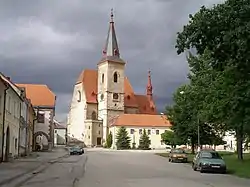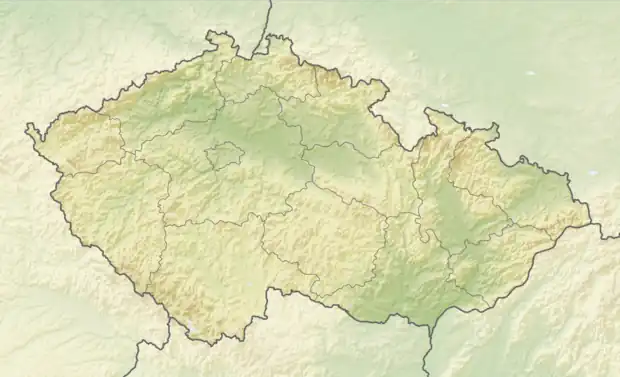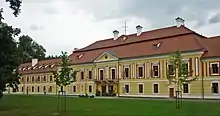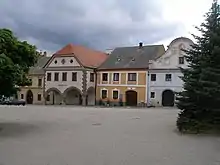Chvalšiny
Chvalšiny (German: Kalsching) is a municipality and village in Český Krumlov District in the South Bohemian Region of the Czech Republic. It has about 1,300 inhabitants. The historic centre is well preserved and is protected by law as an urban monument zone.
Chvalšiny | |
|---|---|
 Church of Saint Mary Magdalene and the square | |
 Flag  Coat of arms | |
 Chvalšiny Location in the Czech Republic | |
| Coordinates: 48°51′15″N 14°12′40″E | |
| Country | |
| Region | South Bohemian |
| District | Český Krumlov |
| First mentioned | 1281 |
| Area | |
| • Total | 27.95 km2 (10.79 sq mi) |
| Elevation | 575 m (1,886 ft) |
| Population (2023-01-01)[1] | |
| • Total | 1,270 |
| • Density | 45/km2 (120/sq mi) |
| Time zone | UTC+1 (CET) |
| • Summer (DST) | UTC+2 (CEST) |
| Postal code | 382 08 |
| Website | www |
Administrative parts

Villages of Borová, Červený Dvůr and Hejdlov are administrative parts of Chvalšiny.
Geography
Chvalšiny is located about 9 kilometres (6 mi) northwest of Český Krumlov and 23 km (14 mi) southwest of České Budějovice. Chvalšiny lies in the Bohemian Forest Foothills. The highest point is at 860 m (2,820 ft) above sea level. The Chvalšinský stream flows through the municipality. Most of the municipal territory lies in the Blanský les Protected Landscape Area.
History
The first written mention of Chvalšiny is from 1281, when it was confirmed as property of Zlatá Koruna Monastery. The settlement rapidly developed and already in 1293, it was referred to as a market town. From 1400 to 1785, the religious administration in Chvalšiny was performed by the monastery. During this period, the German settlers came to the area and slowly formed a majority.[2]
During the Hussite Wars, Oldřich II of Rosenberg acquired most of properties of the monastery, including Chvalšiny. Chvalšiny was owned by the Rosenberg family until 1601, when they sold it to Emperor Rudolf II. From 1622, it was owned by the Eggenberg family, and after their extinction, in 1719 it became property of the House of Schwarzenberg. The Schwarzenbergs held Chvalšiny until the abolition of serfdom in 1848.[2]
In 1938, Chvalšiny was annexed to Nazi Germany. After the World War II, the German population was expelled and the area was resettled by Czech citizens.[2]
Demographics
|
|
| ||||||||||||||||||||||||||||||||||||||||||||||||||||||
| Source: Censuses[3][4] | ||||||||||||||||||||||||||||||||||||||||||||||||||||||||
Sights

The main landmark is the Church of Saint Mary Magdalene. It was built in the late Gothic style in 1487–1507 on the site of an older church.[5]
The former town hall is a Baroque building from 1667. Today it houses the Schwarzenberg Canal Museum and is thus a monument to the architect of the canal Josef Rosenauer, who is a local native.[6]
Červený Dvůr Castle is a Rococo chateau, surrounded by an English park. Today the building serves as a psychiatric hospital.[5]
References
- "Population of Municipalities – 1 January 2023". Czech Statistical Office. 2023-05-23.
- "Historie obce" (in Czech). Obec Chvalšiny. Retrieved 2021-09-07.
- "Historický lexikon obcí České republiky 1869–2011 – Okres Český Krumlov" (in Czech). Czech Statistical Office. 2015-12-21. pp. 15–16.
- "Population Census 2021: Population by sex". Public Database. Czech Statistical Office. 2021-03-27.
- "Památky" (in Czech). Obec Chvalšiny. Retrieved 2021-09-07.
- "Barokní radnice Chvalšiny" (in Czech). Kudy z nudy. Retrieved 2021-09-07.